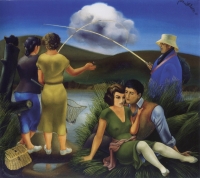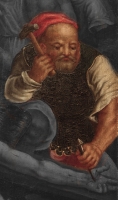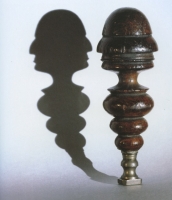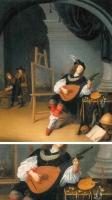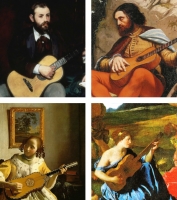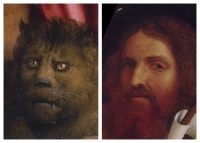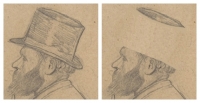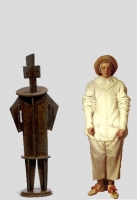21 May 2017
Art’s Timelessness
One of the exciting changes that can happen to you with an EPPH perspective is to discover that we all have the ability to see links between very different images. And the ways we do that are so far removed from conventional understanding that the
05 Apr 2016
The Poetry of Turner’s Eyesight
Artisans everywhere rely on the physical processes of sight. In the past that obvious fact was the basis of too much "interpretation". Impressionist paintings were said to have no meaning because they were exact reproductions of what the artists s
07 Mar 2016 | 1 Comments
Try Sleeping on Dürer’s Pillows
Surprise, surprise. In great art you never stop seeing new perceptions in long-familar images because art by its very nature exists on multiple levels. And seeing them without help from others is both edifying and deeply satisfying, certain to b
14 Nov 2015
Balla’s Initial Idea
The house in Rome of Giacomo Balla (1871-1958), an Italian Futurist painter, is a kaleidoscope of color and creativity. I haven’t visited it but came across this photograph online of four of his clothes hangers. A commentator transcribes the h
17 May 2015
Bread, art and metamorphosis
I just spent the past week learning how to bake bread properly, taught by an artisan baker. The effects were startling. Time passed unnoticed; the scraper became an extension of my body; and only by thinking of what it was like to be the dough d
26 Mar 2015
Ssh! The Secret of Picasso’s Ear
Ears make sense as one of the five: touch, taste, sight, sound and smell. But who thinks about Picasso's ears? We mostly remember his eyes: deep, dark and powerful. Yet he himself - as I don't think has been noted before - seems to have been very
23 Oct 2014
The Male Artist and His Female Muse
Mona Lisa was Leonardo’s muse and he kept the portrait with him until his death. The beautiful, semi-nude La Fornarina was Raphael’s. Titian’s muse and Palma Vecchio’s are both called Beautiful or La Bella in Italian. Parmigianino’s is
24 Sep 2014 | 2 Comments
Reading Art: Manet, Picasso and Alfonso Ponce de Leon
My vision, like most people’s, is often cloudy which is why when the sun breaks and I gain some understanding, I get excited. You must excuse me. It may sometimes seem as if no-one before me has made similar observations. After all, all my ent
20 Aug 2014
The Craftsman’s Christ
This is a scene by an unknown 16th-century artist, probably Flemish, at a time when artisanal effort was admired not just for the perfection of the end-product but for the artisan’s closely-guarded knowledge of materials. Wood, stone, minerals,
19 Jul 2014 | 1 Comments
How many features does a face need?
How much information do we need to recognize a face? Astonishingly little. Here George Washington’s can be recognized in the handle of a wooden seal (c.1810). This explains, perhaps, how artists can continuously convey their features in other
17 Jul 2014 | 1 Comments
Bacon’s Frank about Portraiture
Occasionally an artist's recorded thoughts give hints that their views on portraiture are not conventional. I have quite a collection of them. However someone just sent me this 1971 statement by Francis Bacon in which he completely rejects
26 May 2014 | 1 Comments
Magic from Matisse and Michelangelo
What does Matisse’s figure from Dance II (1910) have to do with Michelangelo’s St Peter from the Last Judgment (1534-41). More than you might think. Bear with me. Both are nude against a blue sky, facing us and facing left; both look a littl
12 Feb 2014
Note on Palette Sounds
My recent post on artists using stringed instruments as metaphoric palettes was restricted to guitars so I did not use this image. Perhaps I should have because while musicians may think lutes and guitars are very different, in artworks they are
09 Feb 2014
Artists and the Thumb-hole of a Guitar
I read once that Cézanne prepared his palette with as many as 18 pigments and lined them up in a series like musical scales.1 It’s an apt analogy because painters have long portrayed musicians as an allegory of their own poetic performance in
04 Feb 2014
A Musical Note and Letters
It's a red-letter day for Raphael. I have been showing a lot of letters recently, how Raphael and Renoir each used objects shaped like an R, how Manet and Matisse used M’s and Ingres used an I. And I doubt before this evening that anyone has e
22 Jan 2014 | 2 Comments
What’s Wrong with the Art World?
What is wrong with the art world? Why can't they see Van Gogh's self-portrait in the fireplace (above)? It is so obvious that a child would recognize it if shown. Whatever the reason, no expert can. That means that this colorful and late self-po
15 Dec 2013
Lotto’s Lion and The Mystical Marriage of St. Catherine
After the recent post about how Sir Edwin Landseer became a couple of dogs (seriously), I thought it would be a good idea to keep up the pace and show how Lorenzo Lotto became a lion. Near the lower edge of one of his greatest masterpieces, The
04 Nov 2013
Do artists still keep secrets?
Is there, as EPPH proposes, a secret tradition, handed down in virtual silence over many centuries, from one artist to another but which is still completely unknown to art historians? I admit that seems unlikely and though I have revealed it in
18 Sep 2013
A Hair-raising Tool to Understand Art
It's interesting to learn something new about an artwork but even more exhilarating to learn the craft itself by acquiring the mental tools used to interpret what few can see. We all paint the world the way we think it or are told to think it by
10 Aug 2013 | 2 Comments
Soak it up! The Story of Degas’ Sponge.
Degas was a well-known miser so some people might still think of him as a sponge. That would be appropriate. Artists don't always handle brushes; they use anything that works, sponges included. A selection sold for use by artists is il
22 Jul 2013
The Imaginative Advantages of Self-Deception
"A serious human life….can hardly begin until we see an element of illusion in what is really there and something real in fantasies about what might be there instead." Northrop Frye (1912-1991)1
Frye, a well-known literary critic (abo
12 Apr 2013 | 7 Comments
How a Scientist Solved the Puzzle of the Mona Lisa
The true identity of Leonardo's Mona Lisa has been a long-running mystery captivating generations of art lovers and scholars. Yet the most crucial piece of information about the Mona Lisa missing from standard textbooks is that the proportions o
10 Apr 2013 | 1 Comments
Leonardo’s Facial Mystery
The discovery that great portraits do not depict identifiable people, as long believed, is a real eye-opener. (See the book free online titled Every Painter Paints Himself.) Yet the significance of what you can now see in portraiture can only be
20 Mar 2013 | 2 Comments
How Degas drew a top hat…
Art is so pregnant that even in a "simple" sketch like Degas' Edouard Manet at the Races (c. 1865) there is always something more. I thought I had drained the drawing when I finished writing about it yesterday (see entry). And, then, this m
13 Feb 2013
Logos (no, not that one!) and Art
Foreign words can sometimes sound more intellectual than those we use in English. That's why when logos is mentioned in reference to art it generally refers to the beginning of St. John's Gospel and is set in italic…"In the beginning
29 Jan 2013 | 5 Comments
2nd Self-Portrait Found in Same Met Gallery!
After discovering a self-portrait by Picasso four days ago (see blog), I think I've discovered another one, this time by Bonnard.....hanging right opposite the other one at the Metropolitan Museum! The "coincidence" demonstrates, if nothing else
25 Jan 2013 | 3 Comments
Picasso’s Unseen Portrait at the Metropolitan Museum
I was going to write about how the objects most frequently depicted by the Cubists in their café still-lifes – pipe, bottle, glass and guitar – were used not primarily as items characteristic of café-life as Rosalind Kr
16 Jan 2013 | 2 Comments
Sotheby’s Head Turner
Two years ago, shortly after I began this website, Christie's sold one of the most important Old Master paintings to come on the market for years: Poussin's Ordination from the collection of the Duke of Rutland. The auction house helped by Pouss
20 Nov 2012 | 1 Comments
Bellows’ River Rats At the Metropolitan Museum.
George Bellows’ exhibition at the Metropolitan Museum opened last week and is well-deserved, showing us for the first time in modern memory the full scale of what he achieved in twenty-something years. He died at 42. The success of h
07 Nov 2012
Jacques Lipchitz as a Jewish Christ
Jacques Lipchitz (1891-1973) was mostly a follower of his period's more innovative artists but that does not mean that he lacked the visual perception to make sense of art. He had that in spades. The bronze, above left, of a Pierrot, a well-
The EPPH Blog features issues and commentary.







